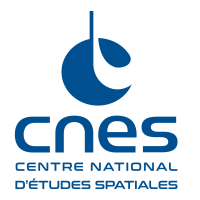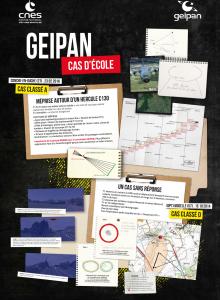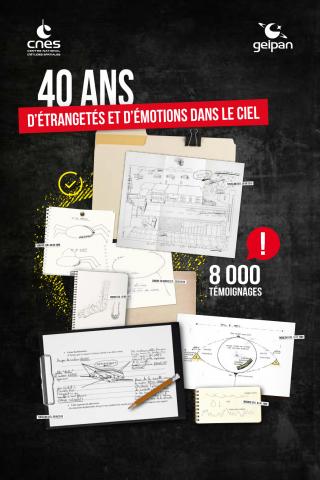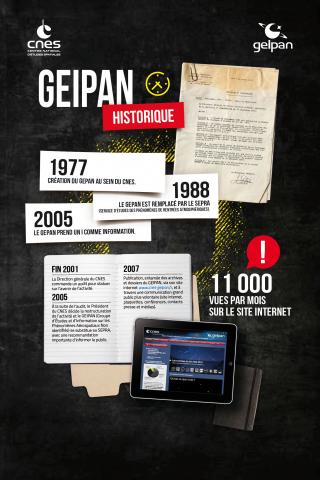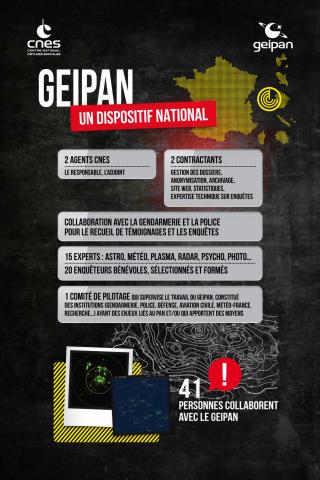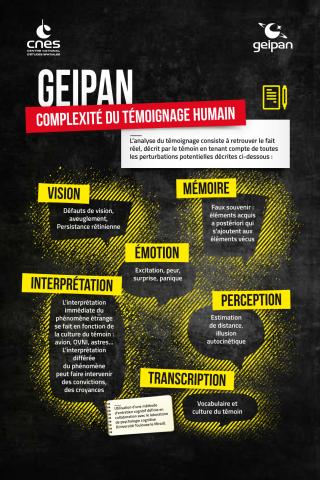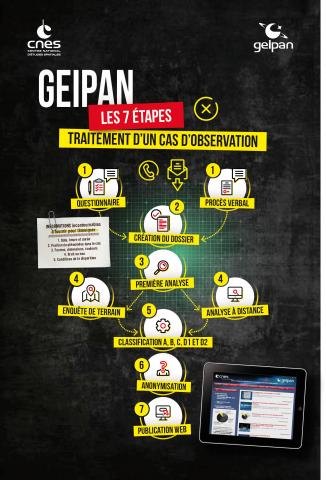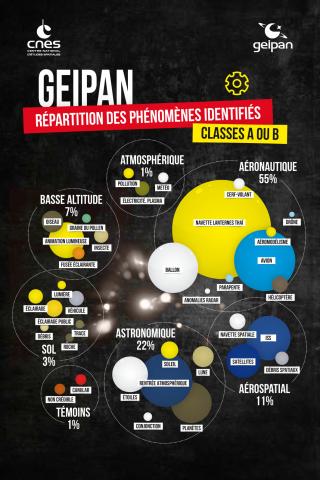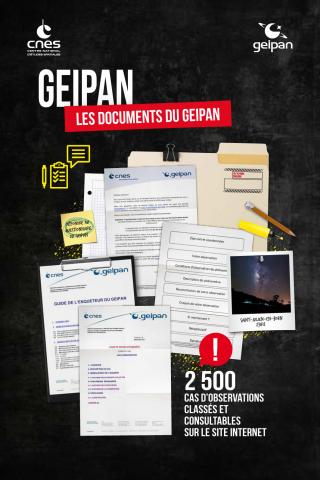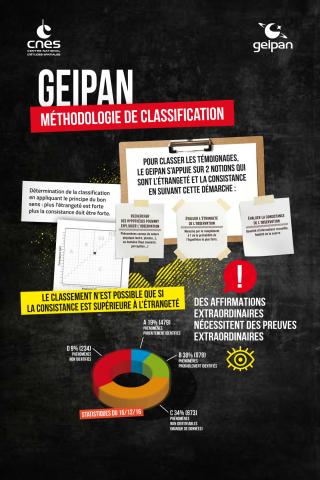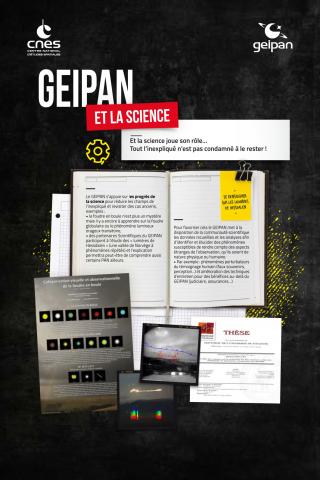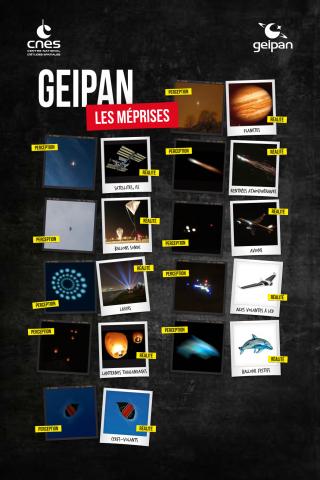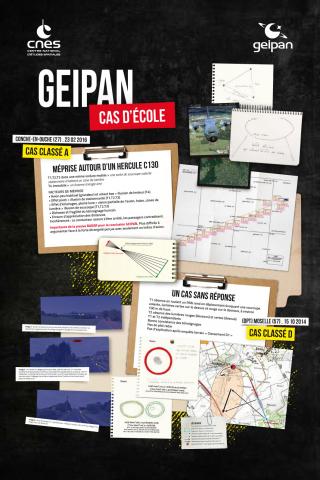POLITIQUE DE GESTION DES COOKIES
Le site Internet du GEIPAN utilise des « cookies », c’est-à-dire des petits fichiers de données ayant pour but de garder des traces de la connexion de l’utilisateur.
Qu’est-ce qu’un cookie ?
Un cookie est un petit fichier stocké par un serveur dans le terminal (ordinateur, téléphone, etc.) d’un utilisateur et associé à un domaine web (c’est à dire dans la majorité des cas à l’ensemble des pages d’un même site web). Ce fichier est automatiquement renvoyé lors de contacts ultérieurs avec le même domaine.
Les cookies ont de multiples usages : ils peuvent servir à mémoriser votre identifiant client auprès d'un site marchand, le contenu courant de votre panier d'achat, la langue d’affichage de la page web, un identifiant permettant de tracer votre navigation à des fins statistiques ou publicitaires, etc. Certains de ces usages sont strictement nécessaires aux fonctionnalités expressément demandées par l’utilisateur ou bien à l’établissement de la communication et donc exemptés de consentement. D’autres, qui ne correspondent pas à ces critères, nécessitent un consentement de l’utilisateur avant lecture ou écriture.
Pour plus d’informations, consultez le site de la CNIL.
Quels types de cookies utilisons-nous ?
Liste des cookies utilisés sur le site Internet du GEIPAN :
- Les cookies techniques et fonctionnels :
Les cookies fonctionnels et techniques sont indispensables à l’utilisation du site Internet. La désactivation de ces cookies peut avoir comme incidence d’empêcher l’utilisation de certaines fonctionnalités du site ou l’affichage de certaines pages.
Plus spécifiquement, ces traceurs répondent aux finalités suivantes :
- Permettre le bon fonctionnement du site, faciliter l’utilisation en adaptant les fonctionnalités;
- Adapter la présentation de notre site aux préférences d’affichage de votre terminal (langue utilisée, résolution d’affichage, système d’exploitation utilisé…) lors de vos visites antérieures;
- Permettre l’authentification de votre accès à nos services;
- Mettre en œuvre des mesures de sécurité pour authentifier les utilisateurs, empêcher l’utilisation frauduleuse d’informations de connexion et protéger les données des utilisateurs des tiers non autorisés.
- Ils permettent de reconnaître et de mémoriser vos préférences et paramètres de navigation tels que vous les avez définies lors d’une précédente visite sur notre site et ce, afin de faciliter votre navigation et la rendre plus agréable.
|
Nom du cookies |
Description |
Durée de vie |
Consentement |
|
lang |
Stocke la langue dans laquelle le site Web est affiché. |
90 jours |
Non |
|
cookie-compliance |
Ce cookie enregistre l’autorisation ou non des cookies sur les différents services proposés. |
365 jours |
Non |
|
GCLB |
Ce cookie est utilisé en conjonction avec la distribution du trafic - Cela permet d'optimiser le taux de réponse entre le visiteur et le site, en distribuant le trafic sur plusieurs liens de réseau ou serveurs. |
5 minutes |
Non |
|
PHPSESSID |
Identifiant de session |
Session* |
Non |
|
SSESS<id> |
Permet de gérer la session |
23 jours |
Non |
|
Drupal.visitor.autologout_login |
Permet la déconnexion automatique des utilisateurs |
365 jours |
Non |
|
Recueillir le consentement des utilisateurs et enregistrer les préférences, par exemple si les utilisateurs ont accepté ou refusé les cookies |
12 mois |
non |
*Session : une session dure jusqu’à la fermeture complète de tous les onglets et fenêtres du navigateur que vous utilisez pour vous connecter au site.
- Les cookies analytiques (Mesure d’audience)
Les données générées par ces cookies d’analyse de navigation concernent votre utilisation du site : sites visités, fréquence, nombre et répétition des visites, durée de navigation, recherches effectuées, navigateur utilisé, opérateur qui fournit le service, emplacement lié à l’adresse IP. Ils permettent d’améliorer la pertinence, l’ergonomie et le fonctionnement des services proposés sur le site (par exemple, les pages les plus souvent consultées, les recherches les plus fréquentes dans le moteur de recherche du site…).
|
Nom du cookie |
Description |
Durée de vie |
|
_pk_ref |
Stocke des informations pour identifier les sites référents afin de comprendre d'où viennent les visiteurs. |
6 mois |
|
_pk_cvar |
Stocke des données personnalisées de visite (variables personnalisées) pour le visiteur. |
Session ou durée définie |
|
_pk_id |
Utilisé pour reconnaître les visiteurs uniques et associer les données de navigation. |
13 mois |
|
_pk_ses |
Utilisé pour stocker temporairement les données de la session active. |
30 minutes |
|
_pk_hsr |
Collecte des données sur les comportements de navigation pour enrichir les analyses. |
30 minutes ou personnalisé |
|
matomo_sessid |
Identifie une session utilisateur spécifique pour la gestion temporaire. |
Durée de la session |
- Les cookies émis sur notre site par des tiers partenaires
L’émission et l’utilisation de cookies par des tiers, sont soumises aux politiques de protection de la vie privée de ces tiers. Nous vous informons de l’objet des cookies dont nous avons connaissance et des moyens dont vous disposez pour effectuer des choix à l’égard de ces cookies.
|
Nom du cookies |
Description |
Durée de vie |
Consentement |
|
AEC |
Utilisé pour la sécurité, prévention des fraudes de google. |
180 jours |
Oui |
|
APISID |
Stocke des préférences utilisateur, notamment sur YouTube. |
400 jours |
Oui |
|
DV |
Utilisé pour des fins publicitaires et pour optimiser les annonces. |
7 minutes |
Oui |
|
HSID |
Utilisé pour sécuriser l'authentification des comptes Google. |
400 jours |
Oui |
|
NID |
Stocke les préférences de recherche, comme la langue et les résultats de recherche. |
395 jours |
Oui |
|
SAPISID |
Stocke des préférences utilisateur et contribue à la personnalisation des services Google. |
400 jours |
Oui |
|
SID |
Contient des informations de session, assure l'authentification et la sécurité des utilisateurs. |
400 jours |
Oui |
|
SIDCC |
Fournit une sécurité supplémentaire pour les sessions utilisateur. |
365 jours |
Oui |
|
SOCS |
Utilisé par Google pour gérer le consentement des cookies et les préférences des utilisateurs. |
395 jours |
Oui |
|
SSID |
Utilisé pour la sécurité et la personnalisation des sessions utilisateur. |
400 jours |
Oui |
|
_Secure-1PAPISID |
Renforce la sécurité des sessions et personnalise la publicité. |
400 jours |
Oui |
|
_Secure-1PSID |
Contribue à la sécurité et à la personnalisation des services publicitaires. |
400 jours |
Oui |
|
_Secure-1PSIDCC |
Sécurise les sessions et les interactions avec les services Google. |
365 jours |
Oui |
|
_Secure-1PSIDTS |
Utilisé pour renforcer la sécurité des connexions Google et pour la personnalisation des annonces. |
365 jours |
Oui |
|
_Secure-3PAPISID |
Utilisé pour la personnalisation et l'affichage d'annonces pertinentes. |
400 jours |
Oui |
|
_Secure-3PSID |
Permet d'afficher des annonces ciblées basées sur les préférences de l'utilisateur. |
400 jours |
Oui |
|
_Secure-3PSIDCC |
Améliore la sécurité et la personnalisation publicitaire pour les utilisateurs. |
365 jours |
Oui |
|
_Secure-3PSIDTS |
Utilisé pour la personnalisation des annonces et la protection des sessions utilisateur. |
365 jours |
Oui |
*Session : une session dure jusqu’à la fermeture complète de tous les onglets et fenêtres du navigateur que vous utilisez pour vous connecter au site.
Comment modifier vos préférences ?
Vous pouvez modifier vos paramètres de cookies ou retirer votre consentement à tout moment sur le site Internet du GEIPAN en cliquant sur le lien : Gestion des cookies
Vous pouvez également régler les paramètres de votre navigateur pour bloquer les cookies. Dans ce cas, il se peut que certaines fonctionnalités de notre site Internet soient indisponibles ou qu’elles ne fonctionnent pas correctement.

